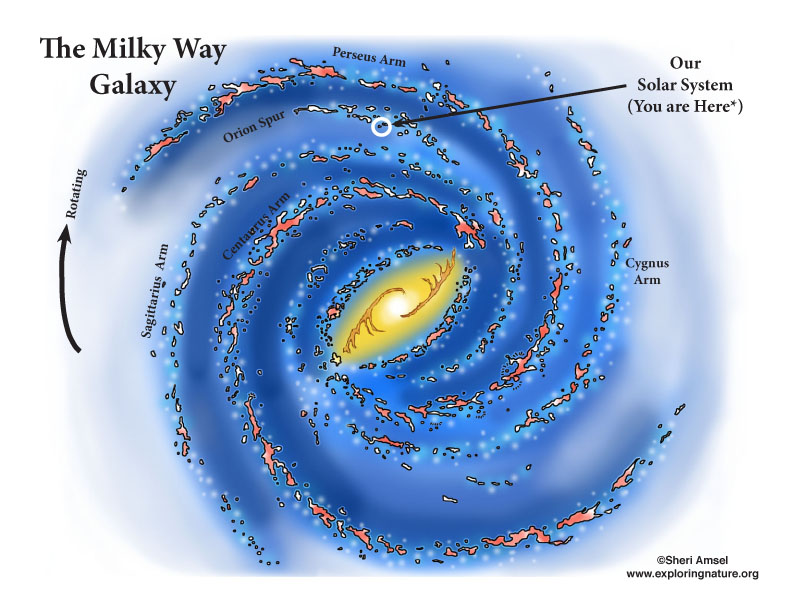


We live in the Milky Way Galaxy, which is just one of millions of galaxies in the Universe. If we could see the Milky Way from space, we would see a spiral galaxy, shaped like a pin-wheel. From Earth, though, the Milky Way looks like a glowing band of light across the sky that is sprinkled with stars.
The Milky Way is a disk galaxy, which means that it’s stars and gas are in a rotating disk, which appears flattened from the side with a bulging center. The building center is called the Galactic Nucleus. This flat plane was first photographed by the Nasa COBE satellite in 1990. (COBE stands for Cosmic Background Explorer).
The Milky Way is thought to have as many as 400 billion stars. Some form “star clusters” where a number of stars were formed together and are bound together by gravity. There are thousands of “open clusters” in the Milky Way, like Pleiades, with a small number of stars. There are much fewer “globular clusters” with hundreds of thousands of stars. So far we only know about 150 globular clusters in the Milky Way galaxy. The Great Globular Cluster has 200,000 stars in it.
The Milky Way also contains nebulae, with are huge, thick clouds of dust and gas where stars are born. They look like fuzzy patches of light in the night sky.
Each of the Milky Way’s spiral arms are thought to be about 4,000 light years wide. The gaps between each arm are about 2,000 light years wide. Our solar system is located on the inner edge of one of the spiraling arms of the Milky Way called the Orion Spur.
Scientists believe that there could be billions of planets orbiting stars in the Milky Way Galaxy. Some may have conditions that could support life, if they are not too hot and not too cold and have water and a protective atmosphere. Scientists call these “Goldilocks Planets.” Are there living things on some of these far away plants? Maybe someday, we will find out.
Hang a Milk Way Galaxy Poster in your classroom.
When you research information you must cite the reference. Citing for websites is different from citing from books, magazines and periodicals. The style of citing shown here is from the MLA Style Citations (Modern Language Association).
When citing a WEBSITE the general format is as follows.
Author Last Name, First Name(s). "Title: Subtitle of Part of Web Page, if appropriate." Title: Subtitle: Section of Page if appropriate. Sponsoring/Publishing Agency, If Given. Additional significant descriptive information. Date of Electronic Publication or other Date, such as Last Updated. Day Month Year of access < URL >.
Amsel, Sheri. "Milk Way Galaxy" Exploring Nature Educational Resource ©2005-2024. December 13, 2024
< http://www.exploringnature.org/db/view/5145 >